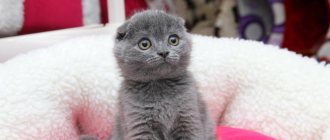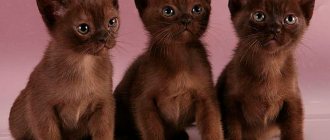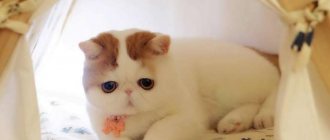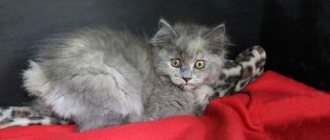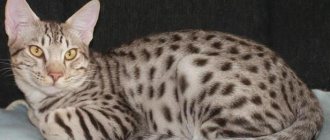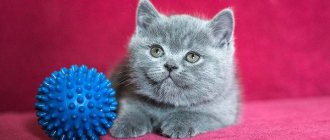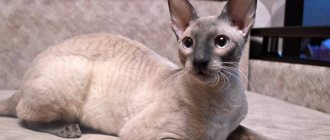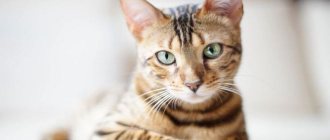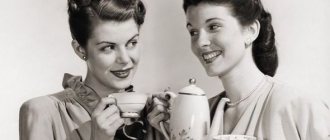The beautiful white British cat looks amazing. Snow-white valuable beauties are popular all over the world; they are often sold to elite homes of wealthy people. They require special, expensive care and close attention. Breeders overcome difficulties in breeding purebred British dogs with a white, uniform coat color, so this species is considered rare, but in demand.
History of the origin of the breed
Historians are convinced that this cat breed was one of the first to appear. Moreover, there is information that animals were brought to Great Britain by the Romans. In ancient images you can see short-haired cream cats, as well as animals whose fur has other shades.
There is another version, according to which the Sacred Beauties came to England from France. The inhabitants of this country always took cats with them on voyages so that they would not allow rats and mice to eat the supplies. When stopping at British ports, the animals accidentally ended up on land.
Believing or not these theories is up to each person. One thing you can’t argue with is that snow-white fluffies are actually incredibly beautiful and gentle.
Golden chinchilla
An even rarer, difficult to breed, but very beautiful, “sunny” variety of the British cat. Its color is so named because of its similarity to the fur of real chinchillas.
This cat wears a bright apricot-colored coat with black or blue “spraying.” The brighter the gold, the more valuable it is. Gray shades are not allowed. The nose and paw pads should match the base color. The eyes are necessarily green, except for the pointed subspecies. The colors differ in the degree of coloring of the hairs.
Golden shaded
Shaded is when only the upper third of the hairs are colored in the main color. In all other respects, the animal looks like it has a solid color, only slightly “dusted.” This effect is achieved due to the fact that each hair has a colored tip. The undercoat is peach or apricot.
Golden veiled
Veiling is when the top 1/8 of the hairs are colored. In all other respects, the animal looks the same as with a solid color, only in a barely visible transparent “veil”. This effect is achieved due to the fact that each hair has a colored tip. The undercoat is peach or apricot.
Description of a white British man
The cutest cats are white breeds with blue eyes. They are soft and loyal.
Features of white color
White color is something unusual and incredibly beautiful. Getting kittens that are “snowy” is problematic. Sometimes breeders, under the guise of white, give away slightly ashen animals - they also look amazing, but still this is a little different. A white British cat with blue eyes resembles the first fallen snow - pure and untouched. This applies to all wool. There can be no talk of any inclusions. Only the pink legs (tufts) create a slight contrast.
Important! White Britons always take better care of themselves than everyone else. Scientists are convinced that animals subconsciously understand their value, so they try to maintain their snow-whiteness at the proper level.
White British kittens
Newly born babies may have small gray stripes that appear in different parts of the body. Over time, the marks lighten and then disappear completely. This is due to the fact that animals of different shades take part in mating. White British babies cannot be born because there is a high risk of deafness in babies.
By the spots, by the way, you can roughly determine the color of the parents. If the stripes are bluish, then either the tom or she-cat is purple. If the markings are gray, black or some other color, then some individual had that shade.
Behavior and intelligence development
The British Shorthair cat is distinguished by its sociability, intelligence and patience with all family members. At the same time, they, like dogs, determine for themselves a single owner, for whom they have selfless, unconditional love.
Just a few days after moving to a new house, the kitten vigilantly watches every move of its leader, escorting him from room to room.
A British kitten will become a faithful friend of any child. He will leniently tolerate children's pranks, but you should not regard the animal as an insensitive toy.
As the cat grows up, it will no longer tolerate a familiar attitude towards itself, gently but persistently pointing the offender to its personal space. In turn, he will also not impose his company on the owner if he is tired at work or is in a bad mood.
A high level of intelligence makes the British pet a full-fledged member of the family. Some owners admit that they do not train their cat, but she trains them. An intelligent, penetrating look creates the impression that the animal fully understands human speech, sympathizes, and empathizes with the interlocutor.
Color of adult cats
British white cats are undoubtedly beautiful, but other shades look no less impressive.
Popular colors are:
- tortoiseshell;
- silver and golden shaded;
- patterned;
- plain and smoky;
- lilac;
- black.
These colors of British cats are truly fascinating.
Tortoiseshell tone
In this case, the coat should have an equal number of tones, and there should be spots on the face. Only cats are tortoiseshells. Beauties can boast a combination of shades such as chocolate/black/brown along with cream/red, as well as lilac/blue. Breeders rarely manage to obtain a tortoiseshell shade.
Silver and golden shaded
The main color can be seen on the back, head, tail and ears. As for the chest, belly, paws and collar, light gray predominates on these parts, which is similar to lilac.
Patterned or tabby
British tabbies can have a variety of body patterns such as leopard spots, distinctive stripes and large markings. At the base of the head, the fur may have a completely different shade - this is the norm. Pictured Britons are divided into many subspecies.
Plain and smoky
Monochromatic cats are those whose coat, including the undercoat, has the same tone. If there is at least one small inclusion, then the animal cannot be called monochromatic. Smoky beauties have a slightly lighter undercoat, due to which the color of their coat “plays” in the sun.
Lilac color
The fur of young kittens resembles a pink color, which transforms with age and becomes light purple. Only the undercoat differs in animals, which has a much lighter shade. As for the eyes of such kittens, they are copper or orange. It is very difficult to get a purple coat color - you need real luck.
Black color
Not only the coat and undercoat have a black (charcoal) tint, but also the skin. This color is rare, but only because kittens that are born charcoal may turn brown or chocolate as they age.
There are many rare colors that are rarely seen. So, there are Britons with dark markings, but the main color can be gray or brown. Many people like such “mixes,” but, unfortunately, “ordering” them is problematic.
ATTENTION, TEST! Answer a few simple questions and find out what kind of owner you are for your cat:
Does your cat have a name?
How often do you play with your pet?
Do you get your vaccinations and parasite treatment up to date?
Is your kitten spayed/neutered?
What do you feed your purr?
What kind of owner are you for your cat?
Your kitty is very happy
Congratulations! Your purr is healthy and happy, surrounded by care and love. You are a responsible and good owner for your kitty.
Your pussy could be happier
Hmm... with such an owner, even the cockroaches will all die. Maybe you should have gotten a cactus instead of a cat? Yes, you are not the best and most caring owner, but you still have a chance to fix everything. Start taking proper care of your pet.
This color of fur is extremely rare in British cats. These animals have a distinctive feature of black eyeliner at the tip of the tail, around the eyes and next to the paw pads. In common parlance, cats with such fur may be called “golden”.
Gray color
One of the most popular colors of British cats is gray fur, without any additional inclusions. Kittens with this color are always blue-eyed. As you grow older, you can see your eye color change to orange.
Cream color
There are extremely rare coat colors in British cats. And this can be considered a cream shade. Animals with such interesting colors do not show white or red patches, or other patches darker than their fur. The earlobes have a light pink tint. Cream colored cats have very beautiful eyes and come in three different colors: copper, orange and gold. In rare cases they may be blue.
Black color
It is extremely difficult to get British cats with black coats, since kittens with such an unusual color for their breed often change the color of their coat to chocolate or brown after just six months.
This is interesting: Caring for a British cat during heat
Character
The white British cat is a real aristocrat.
The main character traits are:
- calm;
- restraint;
- equilibrium;
- indifference (sometimes).
Animals do not like excessive attention, they do not like to be loved and cuddled. “Business people's cats” is what they are sometimes called. These four-legged animals cope well with the absence of their owners, but greet them with great joy.
Unobtrusiveness and obedience are the middle names of these animals. Climbing on curtains, scratching their claws on furniture and getting mad - this is not about them. Once you show them a claw clipper and a toy, you can be calm.
The British get along well with children. If a child starts to pester you, the cats simply turn around and leave. Aggression is something that representatives of this breed never show.
Important! The British have a good sense of what mood their hosts are in, so they either appear at the right moment or, on the contrary, disappear.
Rules for creating a diet
Experienced breeders urge owners to feed British cats ready-made super-premium food. This not only saves time, money and effort, but also provides the animal with all the necessary nutrients, vitamins and microelements. Dry food cleans teeth efficiently and contains components for the prevention of urolithiasis.
The diet for a white cat requires increased attention, since some substances can distort the natural whiteness of the coat. This danger is fraught with cheap economy-class food, attractive due to the large number of flavors, dyes and preservatives. After just a few days of eating cheap food, the owner may notice the first signs of reblooming.
White cats are especially susceptible to allergies. Therefore, spicy, smoked, chemical-laden foods should not appear in their bowls. Otherwise, complications in the form of conjunctivitis, dermatitis and eczema are possible. Chicken and beef in dry food of any quality can cause yellowing of the coat.
Carrots, beet pulp, liver, and seaweed give hair a brown tint. Excess oil causes increased sebum production, causing your cat's coat to become dull and matty.
Each breeder, as he works with the breed, creates his own rating of food that favorably emphasizes the beauty of the snow-white color.
British white cat care
White British kittens must be litter trained from childhood. They remember very well that they need to go to their toilet, so they don’t shit in the wrong places. To avoid problems, from a young age you need to examine your cats eyes, ears, teeth, and also brush them regularly. In the morning, the four-legged eyes may turn sour, so you will need to carefully wipe them with a damp cloth.
Sometimes cats tear their fur. This is due to the fact that lumps collect in the stomach. To eliminate the problem, you need to give the animals a special paste or food from time to time.
British white cats can boast of luxurious fur; in order for it to remain that way, a number of rules must be followed:
- Bath the animal several times a year (maximum 4 times) using special shampoos.
- After bathing, be sure to dry the coat with a hairdryer, as if styling.
- Once a week, brush your pet with a soft brush that does not tear the hairs.
- Coughed clumps should be cut off immediately.
Exterior
The breed standard describes the White British as follows:
- The head is round on all sides, the skull is wide, and there is a pronounced massive chin. The cheeks are round and dense.
- The nose is wide, short and straight.
- The ears are small and rounded. Low set.
- The eyes are large and round, blue, orange or heterochromic.
- The body is massive, with a developed chest and muscular frame.
- The limbs are short and strong.
- The tail is thick, with a rounded end.
- The weight of males is 4.5-8 kg, females - 2.5-5.7 kg.
- The color is perfectly clean and uniform.
The coat is thick and plush to the touch, lying close to the body. Thanks to the developed undercoat, the cat does not freeze in the cold. The white color looks unusual and beautiful, suggesting the complete absence of any other shades, spots, stripes, “smoky” hairs, or yellowness. Often found on the head, near the eyes, and at the base of the tail. A slight contrast is created only by pink paws and the tip of the nose.
Reference. The white British cat takes care of its fur more carefully than its counterparts. Scientists are sure that the cat is aware of its value, so it tries to maintain its snow-whiteness at the highest level.
Cost of kittens
White British kittens are not common, but they do occur. They sell them at a price of 40,000 rubles. The price varies depending on the level of breeders. If you are buying animals for mating, it is recommended to pay attention to the British breed. Four-legged animals have practically no disadvantages, but at the same time they are not considered elite. Therefore, the cost for them is in the range of 22-27 thousand rubles. There is another type of breed called pet. Kittens of this class are very beautiful, but they do not meet all the requirements and standards, so they are sold for 6-10 thousand rubles.
If pedigree does not matter, you can buy a “furry friend” for just a few thousand rubles.
What to feed?
British cats are not at all picky about food and love to eat well. Both natural and industrial feeds are suitable for this. If you choose the latter, it is best to use dry ones. They need to be selected according to the age of your pet, because kittens and adult animals need different amounts of vitamins and minerals. There are also special foods that are intended only for castrated or sterilized individuals.
Of course, you can also use natural food for feeding. They must include the following components:
- fresh meat, it is best to use beef or rabbit, before eating it it must be doused with boiled water;
- fresh or boiled vegetables and fruits - cats love cucumbers or bell peppers most;
- cottage cheese must be included;
- various cereals, such as rice or oatmeal;
- Be sure to give vitamin and mineral supplements, which can be bought in special stores.
You should not overfeed your pets, otherwise they will become obese. But also do not forget about water, which must be in their access zone. It must be cleaned.
And also, you should not give cow's milk, which can even cause stomach upset.
Interesting Facts
White British Shorthair cats are unusual. There are a number of unusual facts that few people know about, but in vain.
Among these:
- Short-haired breeds do not have eyelashes on their eyes. In addition, the eyeballs are located disproportionately in relation to the body, but this does not in any way affect the visual perception of the world by animals.
- Cats have excellent hearing. This is possible due to the nerve endings located in the eyes, due to which any noise immediately enters the auricle.
- The British have an excellent sense of smell, which is fourteen times stronger than that of other felines. This is due to the antennae, which are also responsible for the sense of smell.
- Representatives of the breed are real sleepyheads, because they must sleep at least 14-16 hours a day to recuperate. Some animals spend 18-20 hours sleeping.
- The British are hardy animals, four-legged excellent hunters and can easily catch a mouse or rat.
- Cats rarely meow, which is explained by their reserved and calm nature.
Regardless of what kind of British dog you buy: white, with a silver tint, black, brown or with a different coat color, he will become a true friend and family favorite.
Did you like the article?
Who is better to choose
It is difficult to say which breed is better, British or Scottish. The choice of a pet is based on the preferences of the future owner, daily routine and rhythm of life. The British cat quickly becomes attached to the house and considers himself a full member of the family. He likes to be left alone for a long time, but a purebred animal needs proper care and timely education.
The British man’s appearance is brutal, his behavior is very important. It is no coincidence that previously only the rich segments of the population could afford to keep such cats.
The facial expressions of pets are interesting and funny. Up to a year old, babies are playful and active, but closer to the age of two, the cat’s habits change, she becomes calm and sleepy. The baby loves to sleep, lounging on the plush back.
The Scottish cat, as a kitten and as an adult, is playful and noisy. He will run around at night or run around the apartment with a rubber mouse.
The Scottish woman loves children, she likes the attention of the owner and family members. Everything in it is for a large and noisy company:
- A funny pose in which your pet often sits: on its tail, with its long legs outstretched.
- Or the famous gopher stand, when the baby stretches vertically on its hind legs, tucking its front legs.
- Ability to walk on a leash and follow various commands.
This cat combines the qualities of cats and dogs. Caring for a cat is not difficult. The Scottish favorite cannot stand heights: flying from the top shelves is not possible for the animal due to the structure of its limbs.
How to distinguish a British kitten from a Scottish one
The difference between British and Scottish cats is obvious. It makes no sense for nursery owners to deceive those who want to buy babies of a certain breed.
The smaller the kitten, the more difficult it is to distinguish a British cat from a Scottish pet. Characteristic signs appear as the baby grows older. Therefore, it is better to buy a baby at the age of 2-3 months.
By this time, the Scotchfold ears, straight from birth, will acquire the desired fold. The eye color will gradually begin to acquire a constant shade that matches the color of the animal's coat. A mandatory item when choosing a kitten is to check the baby's tail: for a fold-eared baby, it should be long and mobile. The British have a powerful, thick tail, much shorter than that of the Scot.
The main points of difference between kittens of the British and Scottish breeds, which people pay attention to when choosing babies:
| British kittens | Scottish kittens |
| Heavier paws, clubfoot when walking | Long light limbs |
| Chubby cheeks | Cheekbones are not very pronounced |
| Large baby | Small in size |
| Round head | Elongated skull shape |
Babies do not differ much in their habits: up to a year old, representatives of these breeds are active and respond to play with pleasure. The difference in behavior between the British and Scottish cats will be noticeable in later life.
To the touch, the Scottish have fur that is more fluffy and soft, gliding, while the British have dense and thick fur. An inexperienced buyer will not be able to independently determine what breed the cub belongs to. The difference in behavior between the British and Scottish cats will be noticeable in later life.
Health issues
Since the British Folds were the result of interbreeding, the likelihood of genetic diseases among representatives of this feline species is very high.
British Folds are susceptible to genetic skeletal diseases
Thus, with age, osteochondrodysplasia may appear, expressed in lameness and deformation of skeletal bones (paws, vertebrae). This disease is incurable, so it is important to visit the veterinarian regularly if the kitten’s parents were two lop-eared individuals. If one of the parents had straight ears, the likelihood of pathology is significantly reduced.
In addition, British Fold cats are susceptible to typical diseases of all purring cats:
- viral infections (cat cold) - goes away on its own within two to three days, otherwise you should see a doctor;
- hypertrophic cardiomyopathy (heart pathology) - treatment is long-term (lifelong) and is supportive;
- polycystic kidney disease is an incurable disease; with maintenance therapy, cysts stop growing;
- claw fungus - can be cured with special antiseptic and antifungal solutions;
- infestation with parasites (worms, fleas) - preventive measures for deworming and getting rid of ectoparasites should be mandatory for representatives of the breed.
To maintain the health of your teddy pet, you must regularly visit the veterinary clinic for vaccinations. Vaccination begins at the age of 2.5 months and then every 3-6 weeks until the kitten is 15 weeks old.
This is followed by comprehensive annual vaccination against respiratory tract infections, panleukopenia, ringworm and rabies.
If you follow the rules for caring for your pet and carefully monitor the health of the British Fold, the animal will live up to 12–15 years.

